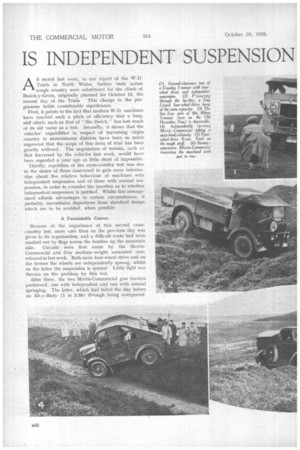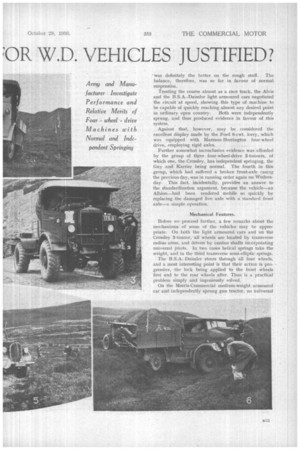IS INDEPENDENT SUSPENSION OR W.D. VEHICLES JUSTIFIED?
Page 42

Page 43

Page 44

If you've noticed an error in this article please click here to report it so we can fix it.
AS stated last week, in our report of the W.D. Trials in North Wales, further tests across rough country were substituted for the climb of 13w1ch-y-Groes, originally planned for October 12, the second day of the Trials This change in the programme holds considerable significance.
First, it points to the fact that modern W.D. machines have reached such a pitch of efficiency that a long, stiff climb, such as that of "the BwIch," has lost much of its old value as a test. Secondly, it shows that the vehicles' capabilities in respect of traversing virgin country in mountainous districts have been so much improved that the scope of this form of trial has been greatly widened. The negotiation of terrain, .3uch as that traversed by the vehicles last week, would have beeri regarded a year ago as little short of impossible.
Thirdly, repetition of the cross-country test was due ' to the desire of those concerned to gain more informa. tion about the relative behaviour of machines with independent suspension and of those with normal suspension, in order to consider the question as to whether independent suspension is jnstified. Whilst this arrangement affords advantages in certain circumstances, it probably necessitates departures from standard design which are to be avoided, when possible.
A Formidable Course.
Because of the importance of this second cross. country test, more care than on the previous day was given to its organization, and a difficult route had been marked out by flags across the heather up the mountain side. Circuits were first made by the MorrisCommercial and Guy medium-weight armoured cars, referred to last week. Both have four-wheel drive and on the former the wheels are independently sprung, whilst on the latter the suspension is normal. Little light was thrown on the problem by this test.
After these, the two Morris-Commercial gun tractors performed, one with independent and one with normal springing. The latter, which had failed the day before on Alt-y-Bady (1 in 3.38) through being overgeared was definitely the better on the rough stuff. The balance, therefore, was so far in favour of normal suspension.
Treating the course almost as a race track, the Alvis and the B.S.A.-Daimler light armoured cars negotiated the circuit at speed, showing this type of machine to be capable of quickly reaching almost any desired point in ordinary open country. Both were independently sprung, and thus produced evidence in favour of this system.
Against that, however, may be considered the excellent display made by the Ford 8-cwt. lorry, 'which was equipped with Marmon-Herrington four-wheel drive, employing rigid axles.
Further somewhat inconclusive evidence was afforded by the group of three four-wheel-drive 3-tonners, of which one, the Crossley, has independent springing, the Guy and Karrier being normal. The fourth in this group, which hail suffered a broken front-axle casing the previous day, was in running order again on Wednesday. This fact, incidentally, provides an answer to the standardization argument, because the vehicle—an Albion—had been rendered mobile so quickly by replacing the damaged live axle with a standard front axle—a simple operation.
Mechanical Features.
Before we proceed further, a few remarks about the Mechanisms of some of the vehicles may be appropriate. On both the light armoured cars and on the Crossley 3-tonner, all wheels are located by transverse radius arms, and driven' by cardan shafts incorporating universal joints. In. two cases helical springs take the weight, and in the third transverse semi-elliptic springs. The B.S.A.-Daimler steers through all four wheels, and a most interesting point is that their action is progressive, .the lock being applied to the front wheels first and to the rear wheels after. Thus is a practical problem simply and ingeniously solved.
On the Morris-Commercial medium-weight armoured car and independently sprung gun tractor, no universal
joints are used and no part of the mechanism is exposed. Hollow arms, with stub axles at one end and free to move about large bosses (on transverse axes) at the other end, carry the wheels. Within each arm is a driving shaft having a bevel at each end, these bevels meshing with similar gears—one on the wheel hub and one on the transverse shaft from the differential. Extensions on the hollow arms sear on helical springs, abutting, at their other ends on frame brackets. More interesting than the rest of the demonstrations and tests made on Wednesday on the moorland at the summit of the Old Horseshoe Pass was the subsequent conference between Army and manufacturer. At this, members of the two camps numbered nearly 100, whilst The COntritercial Motor was the only newspaper ' privileged to be represented.
General Davidson presided and opened the discussion by naming as the outstanding matter of the moment the decision that would have to be taken in connection with independent suspension. He called upon a number of his staff and of the commercial-motor engineers present to express views, and paid a tribute to the manner in which manufacturers were co-operating in Army mechanization. Whilst appreciating the splendid response that had been made to W.D. requirements, he said he was confident that all were influenced by the common motive of making the transport of the British Army the finest in the world.
Insufficient Data.
Numerous important points came under consideration. It was pointed out that frame distortion could be minimized by independent suspension systems, and suggested that wrack and lozenging were particularly undesirable when steel bodywork was used. By this arrangement, too, local overloading of the ground surface could be reduced. Breakages and other troubles had occurred with it, but the system was in its infancy and, in fairness to it, time should be allowed for development. It would be unjust to reject it, on the small amount of data that had so far been amassed. At present, maintenance was admittedly high, but this would in time be lessened. The performances, said a staff officer, on the difficult course that had been witnessed were remarkable, and if all W.D. vehicles were like those that had been demonstrated the Army would indeed be well equipped.
A tendency towards disregard of gross weight was mentioned. High-powered engines, four-wheel-drive, etc., were being obtained at the expense of weight, but in the case of tractors, of course, weight for adhesion was desirable. Differential locks were suggested as affording scope for improvement, in. the latter connection, and the question of economy was mentioned as a limiting factor to performance.
It was pointed out later, that some of the independently sprung machines in the trial had only limited wheel movement. The limit had been shown to be too close, and certain evolutions made by the machines had resulted in only three wheels taking the weight. Greater articulation was needed. Besides this, equal distribution of weight among the wheels was required. No provision was made in the systems of the vehicles tested for balance between wheels such as were afforded by the balance beams on rigid six-wheelers.
From a member of the manufacturers' camp came a view that concerns worked too independently of OM another. Knowledge of what they were doing should be spread.
Armouring Cabs.
On the subject of weight. again, Colonel Crawford, of the War Office, said that, regarding the load-carrying machines, bodywork tended to be too heavy. Nevertheless, he was shortly going to make weight reduction still more difficult by asking for the armouring of cabs. The best could not he expected from the driver of a vehicle under fire, who knew himself to be practically unprotected.
Overall height was an important matter when it came to the shipment Of vehicles abroad, and he hoped that every inch would be saved where possible.
The conference concluded with the expression, by the chairman, of his appreciation of the achievements of manufacturers in building machines which were so close in specification to what the War Department wanted.




















































































